One of the things I do for fun is wordplay. Sometimes it is puns, but another activity is an online Word of the Day forum at Internet Book Database of Fiction. Today’s word:
neomenia
Definitions
from The Century Dictionary and Cyclopedia
n. The time of new moon; the beginning of the month.
n. In antiquity, a festival held at the time of the new moon.
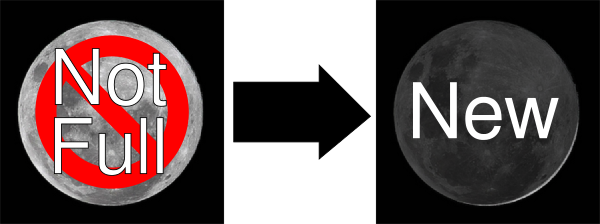
Original full moon photo: Dave Young
-=-=-=-=-=-=-=-=-=-=-=-=-=-=-=-=-=-=-=-=-=-=-=-
There is nothing zanier
Than the feast neomenia.
Rosh Codesh, the Law.
Trumpets, burnt lamb, no flaw.
Once a month with no delay.
Stop to feast, not play.
Music played to glorify
Burned meat, God to supply.
————————————————————-
Examples
The neomenia,
or first day of the moon, kept according to the law, as a festival; and
therefore Saul feasted on that day: and expected the attendance of his
family. (The Bible, Douay-Rheims, Book 09: 1 Kings The Challoner Revision)
—————————————————————
Today, the word was new to me. That happens, but it gives me the chance to use this marvellous thing called the Internet or World Wide Web so I can build some new connections.
WotD participants are adamant that we not repeat words so I’ve made that Rule #1. ODO,
the online dictionary from which I typically gather new words for the forum, gave me “erudite”, but I went to Wordnik for
neomenia. It is a word I don’t remember hearing or reading. Internet searching lead to the Rosh Codesh reference because of the use of neomenia in the Bible. The Rosh Codesh reference came from searching “new moon torah” to see how
the Jewish information jibed with the biblical. Of course, the old
testament is essentially Hebrew in origin, but the terms don’t always
match. This seems to be an example of that. The biblical term is neomenia. The Hebrew/Torah term is Rosh Cadesh or Rosh Hadesh (that
gutteral C/H sound) like “l’chaim”, the Hebrew toasting word.
I guess I’m attempting to be erudite, in spite of the word change!
WotD Forum
The idea of the forum is to write something which uses the day’s word. The writing is not constrained. It can be recording a serious thought. It can be witty, even silly. Sometimes puns are just the thing. Often, my contributions are rhymes. I enjoy the sound of words fitting together and overlapping in rhyme, and the four-line format of a quatrain is comfortable for me. Today’s poem, recorded above, was my contribution.
The illustration is sometimes just a photo which makes the word visual. I try to use images licensed with the Creative Commons reuse/remix licenses. In this case, I went beyond the original photo and remixed a photo of the full moon by Dave Young from Flickr. Flickr has a good CC license search in its advanced search tool.
Learning from it
Many opportunities to learn present themselves every day. Noticing the chance is the first step. Filing the chance away for later is one possibility, but that is tough. It seems like a better strategy to do at least a little preliminary work on the new path so it will begin making connections with what I already know. Connections are “everything” in learning.
I am very fortunate to have the time to start making these connections because I’m retired. The Internet searching isn’t time stolen from a workday. When working, I had to try to store away the chance encounters so I could follow up later. I kept a small notebook in my back pocket. It was better than nothing to avoid having new links slip away in the full day of stuff we all encounter.
An exploring mind is, I believe, also a mind which tries to recognize the little signals of chance which come along. Some will be dead ends, probably, or too complex to work out soon. Either way, getting some connections going will build the mind’s capacity to see connections again in the future.
I do not know what benefits will come from knowing more about neomenia, but that’s OK. Keep in mind that this blog is called “Ramblings.”
Turtle Python
Back in the days when we used the AppleII at the middle school where I taught, we used a package called Delta
Drawing which had some of the features of Logo, the language developed by Wally Feurzeig and Seymour Papert to help develop early programming skills, even for elementary students. For a while Logo was
popular, but as administrators challenged the value of “Programming for
Everybody”, it fell by the wayside as BASIC had earlier. Apparently neither Logo nor BASIC were important enough to be part of the “back to basics” thinking that came with budget cuts.
The STEM initiative (Science, Technology, Engineering, Math) is having some success in education circles these days. In that context programming
is making a resurgence with the support of some heavy hitters in the tech world having political impact.
The “Hour of Code” effort is popular. Python is one of the languages
with traction, too. Python has Turtle Graphics available as a built-in
module. It is possible to use Python programming to do turtle graphics
in almost the same way they were done in earlier Logo implementations.
Turtle graphics are a very good way to introduce the concept of functions in Python.
I purchased a book from a member of the MathFuture Google Group.
Hacking Math Class with Python: Exploring Math Through Computer Programming by Peter Farrell [Link]
His book begins with a section on turtle graphics.
Typing the following code into the command line (Python interpreter
running) window will produce first a square and then a circle in a popup
window (using the built-in tk windowing tools).
python
from turtle import *
def square():
for i in range(4):
fd(100)
rt(90)
square()
def circle():
for i in range(36):
fd(10)
rt(10)
circle()
You might not be surprised that those instructions made a square and circle.
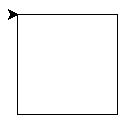
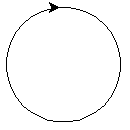
If you learned Logo, you will recognize the fd 100 as meaning “move
the turtle forward 100 steps.” Likewise, rt(90) was rt 90 or right 90
depending on the implementation of Logo you used. What is different is
the indenting of Python and the use of parentheses to indicate the
functions in use along with the Python structure of the loop which was
different in Logo.
Implementing a Logo-like turtle graphics environment in Python does
give us immediate access to visualizing the concepts expressed as
functions, a real leg up in the concept of functions in math.
That, of course, lead me to remember the “flowering” of my earlier
Logo days, and I made the rotations of both square and circle that were
such a rush for me back then.
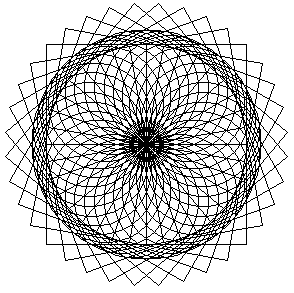
I exemplified a bit of my sponsored wordnik word “explore” by making a
challenge to do a stack of polygons with one side overlapped
(congruent?).
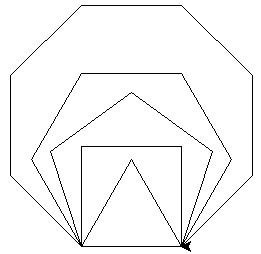
>>> clear()
>>> lt(60)
>>> octogon()
>>> hexagon()
>>> pentagon()
>>> square()
>>> triangle()
I think I may enjoy going further in the book.